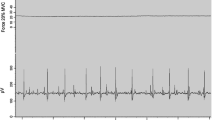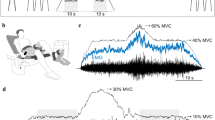Abstract
Declining motor unit discharge rates and H-reflex amplitude have been observed in separate experiments during fatiguing submaximal contractions in humans. The purpose of this experiment was to investigate motor unit discharge rate, H-reflex amplitude, and twitch contractile properties concurrently during a fatiguing submaximal isometric contraction of the ankle plantarflexors. Eleven healthy subjects performed fatiguing contractions of low force (25% maximal voluntary contraction (MVC)) or high force (42–66% MVC). Hoffmann (H)-reflexes, muscle compound action potentials (M-waves), twitch contractile properties, and motor unit discharges were recorded from the soleus muscle. In the low-force fatigue task, motor unit firing rate increased gradually over time, whereas the resting H-reflex was significantly depressed at 15% of endurance time and remained quasiconstant for the rest of the task. This suggests that the processes mediating the resting H-reflex depression are relatively independent of those modulating the motor unit firing rate during a low-force fatigue task. In the high-force fatigue task, a decline in the average motor unit discharge rate was accompanied by a decrease in the resting H-reflex amplitude and a prolongation of the twitch half-relaxation time (HRT) at the completion of the fatigue task. Overall, motor unit firing rate was modulated in parallel with changes in the twitch HRT, consistent with the muscle wisdom hypothesis.








Similar content being viewed by others
References
Allen GM, Gandevia SC, McKenzie DK (1995) Reliability of measurements of muscle strength and voluntary activation using twitch interpolation. Muscle Nerve 18:593–600
Bigland-Ritchie B, Johansson R, Lippold OCJ, Smith S, Woods JJ (1983a) Changes in motoneurone firing rates during sustained maximal voluntary contractions. J Physiol 340:335–346
Bigland-Ritchie B, Johansson R, Lippold OCJ, Woods JJ (1983b) Contractile speed and EMG changes during fatigue of sustained maximal voluntary contractions. J Neurophysiol 50:313–324
Bigland-Ritchie B, Cafarelli E, Vøllestad NK (1986a) Fatigue of submaximal static contractions. Acta Physiol Scand Suppl 556:137–148
Bigland-Ritchie B, Dawson NJ, Johansson RS, Lippold OCJ (1986b) Reflex origin for the slowing of motoneurone firing rates in fatigue of human voluntary contractions. J Physiol 379:451–459
Burke D (2002) Effects of activity on axonal excitability: implications for motor control studies. Adv Exp Med Biol 508:33–37
Capaday C, Stein RB (1986) Amplitude modulation of the soleus H-reflex in the human during walking and standing. J Neurosci 6:1308–1313
Cresswell AG, Löscher WN, Thorstensson A (1995) Influence of grastrocnemius muscle length on triceps surae torque development and electromyographic activity in man. Exp Brain Res 105:283–290
Davies CT, Mecrow IK, White MJ (1982) Contractile properties of the human triceps surae with some observations on the effects of temperature and exercise. Eur J Appl Physiol Occup Physiol 49:255–269
Duchateau J, Hainaut K (1993) Behaviour of short and long latency reflexes in fatigued human muscles. J Physiol 471:787–799
Duchateau J, Balestra C, Carpentier A, Hainaut K (2002) Reflex regulation during sustained and intermittent submaximal contractions in humans. J Physiol 541:959–967
Enoka RM, Hutton RS, Eldred E (1980) Changes in excitability of tendon tap and Hoffmann reflexes following voluntary contractions. EEG Clin Neurophysiol 48:664–672
Enoka RM, Robinson GA, Kossev AR (1989) Task and fatigue effects on low-threshold motor units in human hand muscle. J Neurophysiol 62:1344–1359
Fuglevand AJ, Keen DA (2003) Re-evaluation of muscle wisdom in the human adductor pollicis using physiological rates of stimulation. J Physiol 549:865–75. DOI 10.1113/jphysiol.2003.038836
Gandevia SC (2001) Spinal and supraspinal factors in human muscle fatigue. Physiol Rev 81:1725–1789
Garland SJ (1991) Role of small diameter afferents in reflex inhibition during human muscle fatigue. J Physiol 435:547–558
Garland SJ, Gossen ER (2002) The muscular wisdom hypothesis in human muscle fatigue. Exerc Sport Sci Rev 30:45–49
Garland SJ, McComas AJ (1990) Reflex inhibition of human soleus muscle during fatigue. J Physiol 429:17–27
Garland SJ, Enoka RM, Serrano LP, Robinson GA (1994) Behavior of motor units in human biceps brachii during a submaximal fatiguing contraction. J Appl Physiol 76:2411–2419
Garland SJ, Griffin L, Ivanova T (1997) Motor unit discharge rate is not associated with muscle relaxation time in sustained submaximal contractions in humans. Neurosci Lett 239:25–28. DOI 10.1016/S0304-3940(97)00885-9
Griffin L, Garland SJ, Ivanova T, Gossen ER (2001) Muscle vibration sustains motor unit firing rate during submaximal isometric fatigue in humans. J Physiol 535:929–936
Hayward L, Wesselmann U, Rymer WZ (1991) Effects of muscle fatigue on mechanically sensitive afferents of slow conduction velocity in the cat triceps surae. J Neurophysiol 65:360–370
Hugon M (1973) Methodology of the Hoffmann reflex in man. In: Desmedt JE (ed) New developments in electromyography and clinical neurophysiology. Karger, Basel, pp 277–293
Kawakami Y, Amemiya K, Kanehisa H, Ikegawa S, Fukunaga T (2000) Fatigue responses of human triceps surae muscles during repetitive maximal isometric contractions. J Appl Physiol 88:1969–1975
Kennedy PM, Cresswell AG (2001) The effect of muscle length on motor-unit recruitment during isometric plantar flexion in humans. Exp Brain Res 137:58–64. DOI 10.1007/s002210000623
Kuchinad RA, Garland SJ, Ivanova TD (2001) Reflex inhibition and motor unit discharge rate in fatiguing contractions of human soleus muscle. 31st Annual Meeting, San Diego, Calif., Society for Neuroscience Abstracts 27, part 1, 444
Lin CS, Chan JH, Pierrot-Deseilligny E, Burke D (2002) Excitability of human muscle afferents studied using threshold tracking of the H reflex. J Physiol 545:661–669. DOI 10.1113/jphysiol.2002.026526
Lindström L, Kadefors R, Petersen I (1977) An electromyographic index for localized muscle fatigue. J Appl Physiol 43:750–754
Löscher WN, Cresswell AG, Thorstensson A (1994) Electromyographic responses of the human triceps surae and force tremor during sustained submaximal isometric plantar flexion. Acta Physiol Scand 152:73–82
Löscher WN, Cresswell AG, Thorstensson A (1996) Excitatory drive to the alpha-motorneuron pool during a fatiguing submaximal contraction in man. J Physiol 491:271–280
Maffiuletti NA, Martin A, Babault N, Pensini M, Lucas B, Schieppati M (2001) Electrical and mechanical H(max)-to-M(max) ratio in power- and endurance-trained athletes. J Appl Physiol 90:3–9
Marsden CD, Meadows JC, Merton PA (1983) “Muscular wisdom” that minimizes fatigue during prolonged effort in man: peak rates of motoneuron discharge and slowing of discharge during fatigue. Adv Neurol 39:169–211
Merton PA (1954) Voluntary strength and fatigue. J Physiol 123:553–564
Nielsen J, Petersen N (1994) Is presynaptic inhibition distributed to corticospinal fibres in man? J Physiol 477:47–58
Nordstrom MA, Miles TS (1991) Instability of motor unit firing rates during prolonged isometric contractions in human masseter. Brain Res 549:268–274
Pierrot-Deseilligny E, Mazevet D (2000) The monosynaptic reflex: a tool to investigate motor control in humans. Interests and limits. Neurophysiol Clin 30:67–80. DOI 10.1016/S0987-7053(00)00062-9
Rankin LL, Enoka RM, Volz KA, Stuart DG (1988) Coexistence of twitch potentiation and tetanic force decline in rat hindlimb muscle. J Appl Physiol 65:2687–2695
Rudomin P, Schmidt RF (1999) Presynaptic inhibition in the vertebrate spinal cord revisited. Exp Brain Res 129:1–37. DOI 10.1007/s002210050933
Schieppati M (1987) The Hoffmann reflex: a means of assessing spinal reflex excitability and its descending control in man. Prog Neurobiol 28:345–376
Sejersted OM, Vøllestad NK (1993) Physiology of muscle fatigue and associated pain. In: Vaeroy H, Merksey H (eds) Progress in fibromyalgia and myofascial pain. Elsevier Science Publications, Amsterdam, pp 41–51
Taylor JL, Petersen N, Butler JE, Gandevia SC (2000) Ischaemia after exercise does not reduce responses of human motoneurones to cortical or corticospinal tract stimulation. J Physiol 525:793–801
Vagg R, Mogyoros I, Kiernan MC, Burke D (1998) Activity-dependent hyperpolarization of human motor axons produced by natural activity. J Physiol 507:919–925
Walton DM, Kuchinad RA, Ivanova TD, Garland SJ (2002) Reflex inhibition during muscle fatigue in endurance-trained and sedentary individuals. Eur J Appl Physiol 87:462–468. DOI 10.1007/s00421-002-0670-9
Westerblad H, Duty S, Allen DG (1993) Intracellular calcium concentration during low-frequency fatigue in isolated single fibers of mouse skeletal muscle. J Appl Physiol 75:382–388
Wiles CM, Young A, Jones DA, Edwards RH (1979) Relaxation rate of constituent muscle-fibre types in human quadriceps. Clin Sci 56:47–52
Woods J, Furbush F, Bigland-Ritchie B (1987) Evidence for a fatigue-induced reflex inhibition of motoneuron firing rates. J Neurophysiol 58:125–137
Zehr EP (2002) Considerations for use of the Hoffmann reflex in exercise studies. Eur J Appl Physiol 86:455–468. DOI 10.1007/s00421-002-0577-5
Acknowledgements
This work was supported by a grant awarded to S.J. Garland from the Natural Sciences and Engineering Research Council of Canada and a PGS-A scholarship awarded to R.A. Kuchinad.
Author information
Authors and Affiliations
Corresponding author
Rights and permissions
About this article
Cite this article
Kuchinad, R.A., Ivanova, T.D. & Garland, S.J. Modulation of motor unit discharge rate and H-reflex amplitude during submaximal fatigue of the human soleus muscle. Exp Brain Res 158, 345–355 (2004). https://doi.org/10.1007/s00221-004-1907-0
Received:
Accepted:
Published:
Issue Date:
DOI: https://doi.org/10.1007/s00221-004-1907-0




